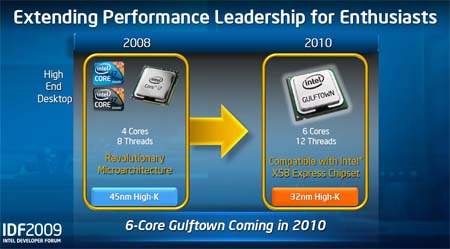Intel, AMD set to release first six-core desktop chips

In the next few months, both Intel and AMD are slated to release the industry's first six-core processors for desktop PCs. Chip makers are pitching these multi-core chips for multi-tasking and multimedia, but real-world consumer applications for six CPU cores remain limited, and for now these are likely to appeal only to PC enthusiasts with deep pockets.
Intel had been expected to release its Gulftown six-core processor sometime in early 2010. Citing desktop component companies in Asia, the site DigiTimes reported this week that Intel will announce the first Gulftown chip, the Core i7 980X, on March 16. Separately DigiTimes reported that AMD's six-core counterpart, known as Thuban, will be launched sometime in May. AMD is expected to release three versions of the Phenom II X6 1000T series.
Six-core processors are nothing new in servers where many tasks are easily distributed across many CPU cores each running multiple threads. Intel has been shipping the six-core Xeon 7400, known as Dunnington, since 2008, and its successor, Nehalem-EX with up to eight processing cores, is due out any day now. AMD released its first six-core Opteron server chip, known as Istanbul, in June 2009. It will be followed this year by a new six-core design--two of which will be combined in a single 12-core processor known as Magny-Cours. These monsters are for high-end servers with sockets for using multiple processors, and there's a real market for them. During AMD's recent earnings call, CEO Dirk Meyer said six-core Opterons accounted for half the company's server units and 60 percent of server revenue last quarter.
Things haven't progressed as quickly on the client side where price trumps performance and, in the case of laptops, quad-cores still use too much power and give off too much heat. Intel announced the first quad-core processor in late 2006, but it was really two 65nm chips in a single package. One year later AMD one-upped Intel with the first true quad-core on a single chip, but the Barcelona launch went badly and it took AMD months to fix problems. Meanwhile Intel kept pushing Penryn-based multi-chip packages including 65nm Kentsfield and later 45nm Yorkfield Core 2 Quads until late 2008, when the company finally introduced its first monolithic quad-core, the Core i7, also at 45nm but based on the Nehalem microarchitecture.
In recent months both Intel and AMD have introduced more quad-core chips and lowered prices (last September AMD released the first sub-$100 quad-core), but the majority of laptops and desktops still rely on dual-core processors. It's telling that Intel chose to introduce its first 32nm Westmere processors earlier this month as dual-core Arrandale and Clarkdale chips designed for mainstream laptops and desktops, respectively.
The Gulftown six-core processor will also be based on Intel's new 32nm process technology, but it is designed for an entirely different audience. Though Intel hasn't given many details, Gulftown has been on the roadmap for some time. Here's a slide from Executive Vice President Sean Maloney's keynote at the Intel Developer Forum in September 2009. At the same event, Intel employees were publicly demonstrating early working silicon (here's a YouTube video on one Gulftown demo). Some sites have speculated that Apple will be the first to get Gulftown as part of a refresh of its Mac Pro desktop line--and there's some precedent for that.
Similarly Thuban has been part of AMD's roadmap at least since the company's analyst day last fall (below is the slide from Senior Vice President Rick Bergman's presentation). Unlike Gulftown, Thuban along with the rest of AMD's desktop and laptop processors will continue to be manufactured using a 45nm process until 2011. Pricing for the Phenom II X6 1000Ts is unknown, but it is likely to be significantly less than Gulftown given that AMD's highest-priced desktop processor, the quad-core 3.4GHz Phenom II X4 965 Black Edition, currently sells for $195.
The question is whether PC enthusiasts will chase these core counts or stick with less-costly chips and spend the rest on better video cards, more memory and other system components such as Blu-ray drives. While it will be interesting to see just what kind of numbers a fast six-core multi-threaded processor with lots of cache can put up on benchmarks, adoption of these high-end chips is likely to be a long, slow process.
